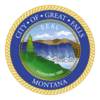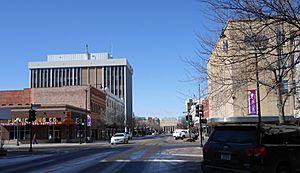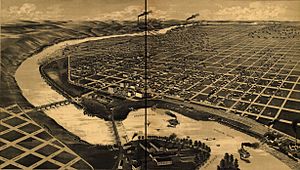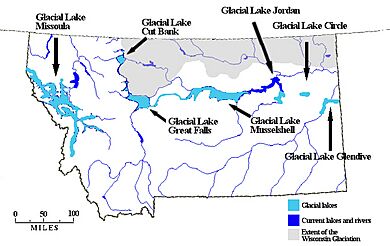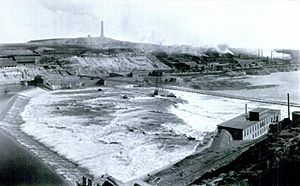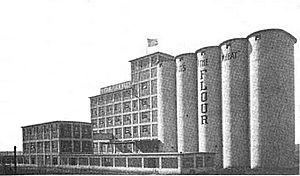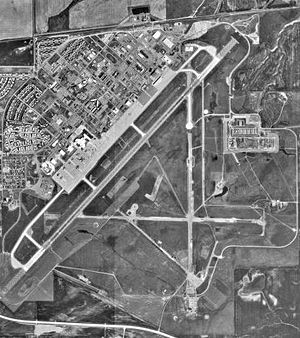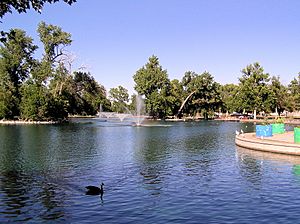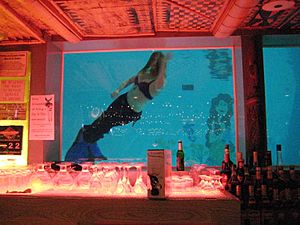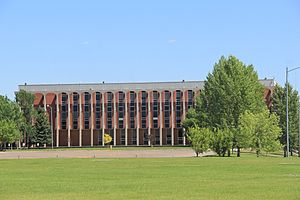Great Falls, Montana facts for kids
Quick facts for kids
Great Falls
|
|||
|---|---|---|---|
|
City and county seat
|
|||
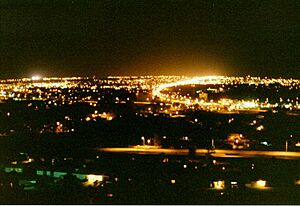 |
|||
|
|||
| Nickname(s):
The Electric City, “ The River City”, “The Western Art Capital of The World”
|
|||
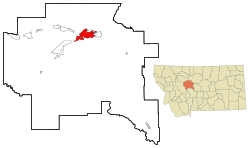
Location within Cascade County and Montana
|
|||
| Country | United States | ||
| State | Montana | ||
| County | Cascade | ||
| Founded | 1888 | ||
| Named for | Great Falls of the Missouri River | ||
| Government | |||
| • Type | Mayor–Council | ||
| Area | |||
| • City and county seat | 23.59 sq mi (61.10 km2) | ||
| • Land | 23.11 sq mi (59.86 km2) | ||
| • Water | 0.48 sq mi (1.24 km2) | ||
| Elevation | 3,333 ft (1,016 m) | ||
| Population
(2020)
|
|||
| • City and county seat | 60,442 | ||
| • Rank | US: 617th | ||
| • Density | 2,615.07/sq mi (1,009.69/km2) | ||
| • Metro | 84,414 (US: 371st) | ||
| Time zone | UTC−7 (MST) | ||
| • Summer (DST) | UTC−6 (MDT) | ||
| ZIP Codes |
59401-59406
|
||
| Area code | 406 | ||
| FIPS code | 30-32800 | ||
| GNIS ID | 2410653 | ||
Great Falls is the third largest city in Montana, a state in the United States. It is also the main city of Cascade County. In 2020, about 60,442 people lived there. The city covers an area of about 23 square miles (61 square kilometers). It is the main city for the Great Falls area, which includes all of Cascade County. This larger area had about 84,414 people in 2020.
Great Falls is an important place for culture, business, and money in central Montana. It is located just east of the Rocky Mountains and has the Missouri River flowing through it. The city is about 180 miles (290 km) from Glacier National Park and 264 miles (425 km) from Yellowstone National Park. A major highway, Interstate 15, goes through the city.
The city gets its name from a series of five waterfalls on the Missouri River. In 1805, the Lewis and Clark Expedition had to carry their boats and supplies around a 10-mile (16 km) stretch of the river to get past these waterfalls. This difficult journey took them 31 days! Three of the waterfalls (Black Eagle, Rainbow, and the Great Falls) are now sites for five hydroelectric dams. These dams produce electricity, which is why Great Falls is called “The Electric City.” Other nicknames for the city are “The River City” and “Western Art Capital of the World.”
Great Falls is also home to two military bases: Malmstrom Air Force Base and the Montana Air National Guard. Malmstrom Air Force Base is the city's biggest employer. The Little Shell Tribe of Chippewa Indians of Montana also has its headquarters in Great Falls.
Many tourists visit Great Falls each year. They spend a lot of money, which helps the city's economy. Great Falls has more museums than any other city in Montana, with 10 in total. These include the Lewis and Clark Interpretive Center and the C. M. Russell Museum. Great Falls was the largest city in Montana from 1951 to 1970.
Contents
History of Great Falls
For a long time, there were no permanent towns in the Great Falls area. However, Salish Indians used to hunt bison there during certain seasons. Around 1600, Piegan Blackfeet Indians moved into the area. They pushed the Salish people back into the mountains and claimed the land where Great Falls is now. The Blackfeet people lived there until the United States took control of the region in 1803 as part of the Louisiana Purchase.
Meriwether Lewis and William Clark explored this new land from 1804 to 1806. They discovered the "Great Falls of the Missouri River" on June 13, 1805.
Over the years, the land where Great Falls sits changed hands many times. It was part of different territories before becoming part of the state of Montana in 1889.
How the City Started
The idea for Great Falls came from Paris Gibson, a businessman from Maine. He visited the Great Falls of the Missouri River in 1880. He was very impressed by how much electricity could be made there. He thought it would be a great place to build a large industrial city.
In 1883, Gibson returned with friends and surveyors. They planned out a permanent settlement on the south side of the river. The first resident, Silas Beachley, arrived later that year. With money from important people like James Jerome Hill (a railroad owner) and Charles Arthur Broadwater, houses, a store, and a flour mill were built in 1884. The Great Falls post office opened in July 1884, and Gibson became the first postmaster. More businesses and a school were built in 1885. By 1887, the town had 1,200 people. When Hill's Great Northern Railway arrived in October 1887, it helped the city grow even more. Great Falls officially became a city on November 28, 1888.
Great Falls quickly became a busy center for industry and supplies. A large factory for processing metals (a smelter) began construction nearby in 1890. That same year, a hydroelectric dam was finished at Black Eagle Falls. This dam gave the new city electricity and was the first major hydroelectric power source in Montana. By the early 1900s, Great Falls was becoming one of Montana's biggest cities. The famous Western artist Charles Marion Russell had his studio there, which was a popular place to visit.
Many important buildings were built in these early years. These included the sandstone Central High School (now the Paris Gibson Square Museum of Art) and the beautiful Cascade County Courthouse (1903).
Railroads and Power Plants
James Jerome Hill, the head of the Great Northern Railway, wanted to connect Great Falls with other cities like Helena and Butte. He knew that the mines in Butte needed to get their metals to market. Paris Gibson helped convince Hill that Great Falls was a great spot for cheap electricity and big industries.
Construction on the railroad line to Great Falls began in late 1886. By October 1887, the link to Great Falls was complete. Service to Helena started in November 1887, and to Butte in November 1888.
Hill also started the Great Falls Water Power & Townsite Company in 1887. Its goal was to develop the city, provide power and water, and attract businesses. To bring industries to Great Falls, he offered low prices for using the railroad. In 1889, a mining company agreed to build a large copper smelter near the dam if the power company could provide enough electricity. The Black Eagle Dam started making electricity in December 1890. By 1912, two more dams, Rainbow Dam and Volta Dam (now Ryan Dam), were also working. Later, Morony Dam was built in 1930 and Cochrane Dam in 1957–1958.
The Big Smelter Stack
In 1908, a very tall brick chimney was built at the smelter site in Black Eagle. This chimney was 506 feet (154 meters) tall. It was built to release fumes from the copper smelting process. When it was finished, it was the tallest chimney in the world! People called it "The Big Stack," and it became a famous landmark. The smelter closed in 1980 after more than 70 years of operation.
The Big Stack had a "sister" stack in Anaconda, Montana, which was built in 1919 and was even taller. Over time, both chimneys started to crack. In 1976, some support bands were taken from the Great Falls Big Stack and sent to Anaconda. This made the cracks in the Great Falls stack worse. Because of safety concerns, the company decided to tear down the Big Stack in 1982.
Interestingly, the first attempt to demolish it didn't work completely! Explosives were used, but a part of the stack remained standing. People in the community were excited, saying the stack was "defiant." Later that same day, more explosives were used, and the rest of the stack finally came down.
From the 1930s to Today
In the early 1900s, Great Falls grew a lot because of new farms, good weather, and strong markets for farm products. It also became a center for banking and shopping. In the late 1930s, new government programs helped build a new Civic Center. During World War II, military bases were built, which helped Great Falls become the largest city in Montana from 1950 to 1970. Planes were even sent to the USSR through Great Falls during the war.
The city continued to grow with the opening of a nearby military base in the 1940s. However, as train travel and shipping slowed down later in the century, and with the closure of the smelter and cuts at Malmstrom Air Force Base in the 1980s, the city's population growth slowed.
In 1950, Great Falls was the site of the Mariana UFO incident, one of the first well-known UFO sightings.
In recent years, the economy of Great Falls has faced challenges, similar to other cities in the Great Plains.
Geography of Great Falls
Great Falls is located near several waterfalls on the Missouri River. It is in the middle of Montana, on the northern Great Plains. The city is close to the Rocky Mountain Front and about 100 miles (160 km) south of the Canadian border. The city covers about 22 square miles (57 square kilometers), with most of it being land and a small part being water.
How the Land Was Formed
The city of Great Falls sits on a special geological area called the Great Falls Tectonic Zone. This is where two very old rock formations meet. The city is also at the southern edge of the Laurentide Ice Sheet. This was a huge sheet of ice that covered much of North America a long time ago.
About 1.5 million years ago, the Missouri River flowed north. But the Laurentide Ice Sheet pushed the river south. Between 15,000 BCE and 11,000 BCE, the ice sheet blocked the Missouri River, creating a huge lake called Glacial Lake Great Falls. Around 13,000 BCE, as the glacier melted, this lake emptied very quickly in a huge flood. The Missouri River then settled into its current path, flowing east around the melting ice. As the ice retreated, meltwater from Glacial Lake Great Falls carved out the Shonkin Sag. This is a mile-long, 500-foot (150 m) deep channel, known as one of the most famous ancient meltwater channels in the world.
Climate in Great Falls
Great Falls has a cold, semi-dry climate. Winters are very cold, long, and often snowy. However, warm winds called chinook winds can cause temperatures to rise above 50°F (10°C) about fifteen times during winter. Without these winds, it can get very cold, with temperatures dropping to 0°F (-18°C) or colder about 20 nights a year. Summers are hot and dry, with highs reaching 90°F (32°C) about nineteen days a year. But the temperature can drop a lot between day and night. Sometimes, it can even snow in early or late summer, though this is rare.
| Climate data for Great Falls, Montana (Great Falls Int'l), 1991–2020 normals, extremes 1891–present | |||||||||||||
|---|---|---|---|---|---|---|---|---|---|---|---|---|---|
| Month | Jan | Feb | Mar | Apr | May | Jun | Jul | Aug | Sep | Oct | Nov | Dec | Year |
| Record high °F (°C) | 67 (19) |
70 (21) |
78 (26) |
89 (32) |
100 (38) |
102 (39) |
107 (42) |
106 (41) |
102 (39) |
91 (33) |
76 (24) |
69 (21) |
107 (42) |
| Mean maximum °F (°C) | 57.1 (13.9) |
57.8 (14.3) |
66.7 (19.3) |
75.4 (24.1) |
82.7 (28.2) |
89.5 (31.9) |
97.1 (36.2) |
97.1 (36.2) |
90.8 (32.7) |
79.4 (26.3) |
64.9 (18.3) |
55.4 (13.0) |
98.8 (37.1) |
| Mean daily maximum °F (°C) | 35.3 (1.8) |
37.1 (2.8) |
46.1 (7.8) |
54.9 (12.7) |
64.6 (18.1) |
72.8 (22.7) |
84.3 (29.1) |
83.2 (28.4) |
71.7 (22.1) |
57.0 (13.9) |
43.7 (6.5) |
35.6 (2.0) |
57.2 (14.0) |
| Daily mean °F (°C) | 25.2 (−3.8) |
26.2 (−3.2) |
34.1 (1.2) |
42.4 (5.8) |
51.5 (10.8) |
59.4 (15.2) |
67.9 (19.9) |
66.7 (19.3) |
57.2 (14.0) |
44.8 (7.1) |
33.6 (0.9) |
26.0 (−3.3) |
44.6 (7.0) |
| Mean daily minimum °F (°C) | 15.0 (−9.4) |
15.4 (−9.2) |
22.1 (−5.5) |
29.9 (−1.2) |
38.4 (3.6) |
45.9 (7.7) |
51.4 (10.8) |
50.3 (10.2) |
42.8 (6.0) |
32.6 (0.3) |
23.6 (−4.7) |
16.3 (−8.7) |
32.0 (0.0) |
| Mean minimum °F (°C) | −15.2 (−26.2) |
−9.0 (−22.8) |
−1.9 (−18.8) |
13.9 (−10.1) |
25.8 (−3.4) |
35.9 (2.2) |
41.9 (5.5) |
40.1 (4.5) |
29.3 (−1.5) |
13.5 (−10.3) |
−2.7 (−19.3) |
−10.8 (−23.8) |
−24.6 (−31.4) |
| Record low °F (°C) | −44 (−42) |
−49 (−45) |
−32 (−36) |
−10 (−23) |
12 (−11) |
31 (−1) |
35 (2) |
30 (−1) |
10 (−12) |
−11 (−24) |
−25 (−32) |
−43 (−42) |
−49 (−45) |
| Average precipitation inches (mm) | 0.55 (14) |
0.59 (15) |
0.68 (17) |
1.73 (44) |
2.43 (62) |
2.72 (69) |
1.23 (31) |
1.22 (31) |
1.33 (34) |
1.07 (27) |
0.68 (17) |
0.53 (13) |
14.76 (374) |
| Average snowfall inches (cm) | 9.2 (23) |
10.1 (26) |
10.1 (26) |
9.4 (24) |
1.9 (4.8) |
0.3 (0.76) |
0.0 (0.0) |
0.3 (0.76) |
0.8 (2.0) |
5.2 (13) |
9.2 (23) |
9.6 (24) |
66.1 (167.32) |
| Average precipitation days (≥ 0.01 in) | 6.9 | 8.2 | 8.1 | 10.0 | 11.3 | 11.8 | 7.1 | 6.8 | 7.1 | 7.4 | 6.5 | 6.5 | 97.7 |
| Average snowy days (≥ 0.1 in) | 7.4 | 8.1 | 6.8 | 4.6 | 1.4 | 0.2 | 0.0 | 0.1 | 0.2 | 3.3 | 6.1 | 7.1 | 45.3 |
| Mean monthly sunshine hours | 125.1 | 151.7 | 237.5 | 245.7 | 286.6 | 316.5 | 377.4 | 330.8 | 254.4 | 200.4 | 124.8 | 105.4 | 2,756.3 |
| Source 1: NOAA (sun 1961–1990) | |||||||||||||
| Source 2: NOAA | |||||||||||||
Nearby Towns and Communities
The Great Falls area includes several nearby towns and communities. These include:
- Black Eagle
- Malmstrom AFB
- Belt
- Cascade
- Fort Shaw
- Gibson Flats
- Monarch
- Neihart
- Sand Coulee
- Simms
- Sun Prairie
- Sun River
- Ulm
- Vaughn
Population Changes in Great Falls
| Historical population | |||
|---|---|---|---|
| Census | Pop. | %± | |
| 1890 | 3,979 | — | |
| 1900 | 14,930 | 275.2% | |
| 1910 | 13,948 | −6.6% | |
| 1920 | 24,121 | 72.9% | |
| 1930 | 28,822 | 19.5% | |
| 1940 | 29,928 | 3.8% | |
| 1950 | 39,214 | 31.0% | |
| 1960 | 55,244 | 40.9% | |
| 1970 | 60,091 | 8.8% | |
| 1980 | 56,725 | −5.6% | |
| 1990 | 55,097 | −2.9% | |
| 2000 | 56,690 | 2.9% | |
| 2010 | 58,505 | 3.2% | |
| 2020 | 60,442 | 3.3% | |
| source: U.S. Decennial Census |
|||
In 2010, Great Falls had 58,505 people living in 25,301 households. About 28.6% of households had children under 18. The average age in the city was 39 years old.
Economy of Great Falls
Past Economy
Great Falls started as a railroad center. In its early years, it relied a lot on processing metal ores. The Black Eagle Dam, built in 1890, was the first hydroelectric dam in Montana. It helped give Great Falls the nickname "The Electric City." A large metal processing factory (smelter) was built in the city because of the cheap power from the dam. By 1892, over 1,000 people worked at the smelter. The energy industry grew even more when oil was found nearby in the late 1910s.
Great Falls faced tough economic times in 1893. Many businesses closed, and the price of silver dropped, causing mines to shut down. However, the smelter helped the city by continuing to employ many workers. Farmers and ranchers also worked to improve their practices and get help from the government.
The city became a major center for farm products. Wheat production grew a lot, and by 1920, there were 11 train lines from the city to collect grain. Cheap electricity made it perfect for milling grain and refrigerating meat. Great Falls became a big hub for farmers and ranchers. Large flour mills like Royal Milling Company and Montana Flour Mills opened. Brewing beer also became a big industry. The city's location near cattle-rich areas also led to a large meat packing industry.
The city's population grew rapidly, reaching 30,000 by 1913. Great Falls also became known as a regional banking city and a place for healthcare. Large deposits of natural materials like clay and limestone led to factories making bricks, cement, and other building materials.
A major drought hit the area in 1917, followed by locusts in 1919 and strong winds that damaged the soil in 1920. This created a "dust bowl" effect. Farmers struggled, and many left the state. The local coal mining industry also collapsed in the 1920s. Even though the country's economy improved after 1922, Great Falls and Montana remained in a tough economic period until the mid-1920s.
The city's economy struggled during the Great Depression. The price of copper fell, and the Anaconda company closed its plant in Great Falls, causing many people to lose their jobs. Farm prices also crashed. Many farmers lost their land. Great Falls was one of the few places in Montana that still grew in population during this time.
World War II brought a big change. East Base (now Malmstrom Air Force Base) was built in Great Falls in 1941. The war created a huge demand for farm products and metals. The base brought thousands of new residents to the city, leading to a housing boom. The base also changed the city's culture as many military personnel stayed after retirement. The Great Falls Municipal Airport also improved a lot during the war.
By 1950, Great Falls was Montana's largest city. It grew because of more government money in defense and healthcare. It became an important center for meetings, trade, and medical services. In 1951, Anaconda opened an aluminum smelter in the city. The O.S. Warden Bridge opened in 1951, helping to develop 10th Avenue South into a busy business district. New hospitals and colleges were also built along this road.
Great Falls became known as a shopping hub for central Montana in the 1960s. Several shopping centers opened, like the Holiday Village Mall. The city was also a major center for selling farm equipment. The Great Falls Livestock Commission Company became an important place for livestock auctions.
In the 1960s, Great Falls seemed to have a very bright future. Its population grew quickly, and it was the largest city in Montana in 1965. Experts thought it would have 100,000 people by 1981.
However, the economy of Great Falls began to shrink in the 1970s. The Anaconda Copper company faced big financial losses and closed its smelter in Great Falls in 1980. About 1,450 high-paying jobs were lost. There were also big cuts at Malmstrom Air Force Base, leading to more job losses.
Current Economy
Since 2008, Great Falls' economy has grown slowly. Growth has been strongest in construction, manufacturing, business services, healthcare, retail, and tourism. The city's slow population growth and low prices for farm products have made it harder for the economy to grow.
The slow growth has also led to more poverty in the city. In 2016, nearly 20% of Great Falls residents lived in poverty. Home prices in Great Falls are also lower than in other large Montana cities.
A 2016 report predicted that manufacturing, retail sales, and tourism would drive the city's economy in the future. The city has been trying to rebuild its agricultural processing industry. In 2016, Great Falls received a grant to open a Food and Ag Development Center. Working with BNSF Railway, the city turned old railroad land into a large industrial site for food and agricultural processing called AgriTech Park. Several large companies have moved into this park.
Military Presence
Great Falls is home to Malmstrom Air Force Base and the 341st Missile Wing. This wing manages and secures Intercontinental ballistic missiles (ICBMs) and their facilities. These missiles are spread out over a huge area, about the size of West Virginia.
Malmstrom also has the 819th RED HORSE Squadron and the 219th RED HORSE Squadron of the Montana Air National Guard. These are special units that can deploy quickly.
Great Falls International Airport is home to other military units, including the Montana Air National Guard's 120th Airlift Wing, which flies C-130H cargo planes. Two U.S. Army Reserve units are also based at the airport.
Arts and Culture
Great Falls has its own symphony orchestra, which started in 1959. They perform concerts and support youth orchestras.
The city is also famous for the unique Sip 'n Dip Lounge. This is a tiki bar located in the O'Haire Motor Inn. It has an indoor swimming pool that you can see through a window from the bar. Women dressed as mermaids swim in the pool! In 2003, GQ magazine called it one of the top 10 bars in the world. It also has an older piano player named "Piano Pat," who is known for her interesting versions of old songs.
Four Seasons Arena
The Four Seasons Arena is a large indoor sports and exhibition building in Great Falls. It was built in 1979 and was mainly used as an ice rink. After some changes, it became a space for indoor sports and exhibitions. It is the largest venue for shows, music, and sports in the city.
Sports in Great Falls
| Club | Sport | League | Stadium (or arena) |
|---|---|---|---|
| Great Falls Voyagers | Baseball | Pioneer League | Centene Stadium |
| Great Falls Americans | Ice Hockey | North American 3 Hockey League | Great Falls Ice Plex |
Great Falls has a long history with baseball, thanks to the Voyagers team. Famous players like Pedro Martínez and Raúl Mondesí have played for the team. Since 1988, the Voyagers have won the Pioneer League championship six times. Great Falls has also been home to the Great Falls Americans Junior A ice hockey team since 2011.
Education in Great Falls
The Great Falls Public Schools system includes elementary and high schools for the entire city. This system covers Great Falls, Black Eagle, Gibson Flats, Malmstrom Air Force Base, and parts of Sun Prairie and Ulm.
There are 20 schools in the system. These include two public high schools: Great Falls High School and Charles M. Russell High School. There is also an alternative high school, Paris Gibson Education Center. The city has two middle schools and 15 elementary schools.
The state-run Montana School for the Deaf & Blind is also in Great Falls.
Great Falls also has many private schools, most of which are supported by religious groups. These include Catholic schools like Our Lady of Lourdes Catholic School and Great Falls Central Catholic High School. Other religious groups also sponsor schools in the city.
Great Falls is home to three colleges. Great Falls College Montana State University is a two-year public college. The University of Providence, a private, four-year Catholic university, was founded in 1932. Apollos University is a private online university. In 2023, a new medical school, TouroCOM Montana, will open in Great Falls.
The city also has a public library, the Great Falls Public Library.
Media in Great Falls
Radio Stations (AM)
- KMON 560
- KEIN 1310
- KXGF 1400
- KQDI 1450
Radio Stations (FM)
- KGPR 89.9
- KLFM 92.9
- KMON-FM 94.5
- KVVR 97.9
- KAAK 98.9
- KLSK 100.3
- KMXM 101.9
- KINX 102.7
- KIKF 104.9
- KQDI-FM 106.1
- KIMO 107.3
Television Channels
Newspapers
The Great Falls Tribune is the local newspaper. It is now printed in Helena, Montana, and delivered daily to Great Falls.
Transportation in Great Falls
Air Travel
Great Falls is served by Great Falls International Airport. It has four passenger airlines and five cargo airlines. Some of these use large jet aircraft for service to the city.
Highways
Several highways serve Great Falls, connecting it to other parts of Montana and beyond:
 Interstate 15
Interstate 15 Interstate 15 Business/Interstate 315
Interstate 15 Business/Interstate 315 U.S. Route 87
U.S. Route 87 U.S. Route 89
U.S. Route 89 Montana Highway 3
Montana Highway 3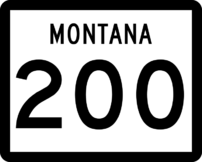 Montana Highway 200
Montana Highway 200
Famous People from Great Falls
- Walter Breuning (1896–2011), once the oldest man in the world
- James R. Browning, judge
- Dorothy Coburn, silent-movie actress
- Walter Coy, actor
- Scott Davis, figure skater
- Dave Dickenson, Canadian Football League quarterback
- Patrick Dwyer, National Hockey League player
- Todd Foster, Olympic boxer
- Ted Geoghegan, horror filmmaker
- John Gibbons, Major League Baseball manager
- Paris Gibson, U.S. Senator, city founder
- Missy Gold, child actress
- Tyler Graham, professional baseball player
- A.B. Guthrie Jr., author
- Paul G. Hatfield, judge and U.S. Senator
- Lester Hogan, technology pioneer
- George Horse-Capture, Native American activist
- Josh Huestis, NBA player
- Patrick M. Hughes, Lieutenant General in the U.S. Army
- Alma Smith Jacobs, librarian
- Jay L. Johnson, U.S. Navy admiral
- Edward McKnight Kauffer, graphic designer
- Pert Kelton, actress
- Ryan Lance, CEO of ConocoPhillips
- Ryan Leaf, former NFL quarterback
- Barbara Luddy, actress
- Howard Lyman, vegetarian activist
- Mike Mansfield, U.S. Senator and Ambassador
- Linda McDonald, drummer
- Gerald R. Molen, film producer
- George Montgomery, actor
- Dallas Neil former NFL punter
- Tom Neville, NFL player
- John Misha Petkevich, figure skater
- Charley Pride, country singer
- Merle Greene Robertson, archaeologist
- Charles Marion Russell, western artist
- Brian Salonen, tight end for the Dallas Cowboys
- Jaymee Sire, ESPN sportscaster
- Wallace Stegner, author
- Haila Stoddard, actress
- Al Ullman, U.S. Congressman
- Thomas C. Wasson, diplomat
- Reggie Watts, comedian, musician
- Bill Zadick, wrestler
- Mike Zadick, wrestler
Sister City
Great Falls has one sister city: Lethbridge, Alberta, Canada.
See also
 In Spanish: Great Falls (Montana) para niños
In Spanish: Great Falls (Montana) para niños



